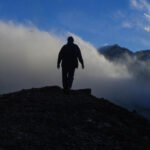Attendees at a recent AST1 Course near Powder King check the snow conditions. Randy Gulick photo.
People who like to get out into the backcountry should be careful this year, says Ryan Shelly, owner of Summit Avalanche Consulting.
“Spring could be an exciting time for the North Rockies snow pack and not in the way we’d prefer to experience it,” says Shelly. “The low snow volume we experienced in December and January , coupled with cold weather have really ‘dried out’ the Basal/foundational part of our North Rockies snow pack.”
The most recent report by the Northern Rockies Field Team measured 90 cm of snow in the Core Lodge area, with many scoured ridges. In exposed terrain, they found stubborn wind slabs over top of sugary crystals from the cold weather a few weeks ago, creating potential hazard areas.
I talked to Shelly shortly before an avalanche in the Hasler area near Chetwynd killed one rider and injured two others.
Four people were riding the Sunshine Bowl on January 27, when one rider triggered a slab avalanche in conditions similar to what was reported in the Core Lodge area. The avalanche buried three others. Two were partially buried and managed to escape. The third did not, becoming the province’s first avalanche fatality of the year.
At this writing, the entire Northeast area was rated 4+, or extremely dangerous.
As a result, Avalanche Canada is recommending those not travelling in the backcountry right now.
And, while conditions may settle over the next little while, Shelly says, this layer could come back to haunt riders in the spring. “A cold, dry and shallower than usual snow pack can reduce the bonding ability of new incoming snow leading to some potential long term instabilities that could last us well into spring.”
Randy Gulick from Wild River Adventure Tours submits many of the avalanche reports from the Tumbler Ridge area to the Avalanche Canada website (www.avalanche.ca). He sent along a picture of a test pit he dug earlier this year. “ From this you can see the top layer of ‘precipitation particles’, also known as fresh snow. Underneath that, there is a layer of surface hoar, which is also known as a ‘persistent weak layer’. This layer is weak because the frost is almost like feathers, standing on end and the newer snow sits lightly on top. When the frost collapses, either from weight, like a snowmobiler/skier/snowshoer, or a fresh layer of heavy snow, or even warm weather, the newer snow that wasn’t able to properly adhere to the layer below the frost, could slide. This could be an issue if this is hidden in the snow pack throughout the season, and could be triggered at a later date.”
Hey says there are three key things to do when sledding. “Get the forecast, get the gear and get the training.”
There are five red flags in avalanche terrain, says Gulick. “First, if you witness recent avalanche activity in your riding area. Second, signs of persistent weak layers as you’re travelling. This can be cracks forming in the snow, or hearing a whoomping sound as the snow settles. Third, recent high wind activity that could create wind slabs. Fourth, recent heaving snow loading. And finally, rapid warming to above 0 in the last 24 hours. If any of these signs are present, proceed with caution, or better yet, don’t proceed into avalanche terrain at all.”
Ryan Shelly says that the best way to keep on top of what’s happening in the backcountry is by keeping an eye on the Avalanche Canada North Rockies bulletin. He predicts the words “persistent weak layers” will be there for most of the season. “This info will become critical as the season progresses as we continue to build snow accumulation in our favourite riding areas.”
Summit Avalanche Consulting (www.summitavalancheconsulting.com) does regular AST1 courses throughout the fall and winter months with many of the field days being in the Tumbler Ridge area, while Wild River Adventure Tours (wildrivertours.ca) rents out avalanche gear.
Trent is the publisher of Tumbler RidgeLines.

